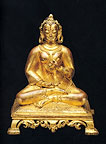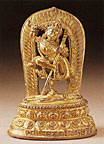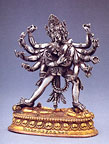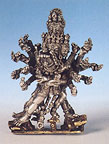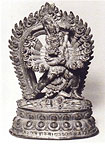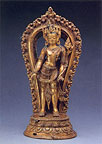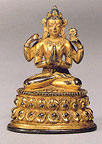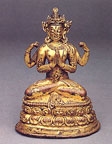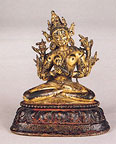| Endnotes:
1a. I have chosen
to call these kings by the name they used for their country and people,
‘Khasa’. This is the name that appears in the thirteenth-century
Bodh Gaya inscription from the time of Aśokacalla, who is described
as the king of ‘Khasadeśa’ see Sircar (1983)
vol. 2, p. 149. See also Vajracarya (Jumla, vs 2028, 1971 AD)
p. 21. The Gopalarāja vaṃśāvalī refers
to these people as the ‘Khasiya’, see Vajracarya,
(vs 2028, 1971 AD), pp. 11-44. The name or term Khasa (or Khas) has long
been used to refer to the Nepali language – Nepali, ‘Khas
Kura’; Newari, ‘Khay’ (from ‘khasa’), ‘Bhay’
– and to that ethnic/caste group now known as the Chetris; even
now the entire Nepali-speaking group, consisting of several castes, is
referred to by the Newars as ‘Khay’, modern Newari for old
Newari ‘Khasa’ or ‘Khaśa’.
In modern Nepalese
society, Malla is a name used in West Nepal by certain families of the
Thakuri, the group to which the present royal family belongs. For a discussion
of the modern ethnic make-up of the Karnālī region, see
Sharma (1972), pp. 14 -16.
1. Pratapaditya Pal,
The Art of Tibet (New York: The Asia Society,1969) fig.51, p.146
147.
2. Beguin, Dieux
et Demons de l'Himalaya, no. 16, p. 70; fig.16 p.73. dated "antérieur
au XVe s.(?)"
3. von Schroeder,
Indo-Tibetan Bronzes p.348, fig. 90B.
4.Pratapaditya Pal,
The Art of Tibet (New York: The Asia Society,1969) fig.51, p.146
147.
5. von Schroeder,
Indo-Tibetan Bronzes p.348, fig. 90B.
6. Beguin, Dieux
et Demons de l'Himalaya, no. 16, p. 70; fig.16 p.73. dated "antérieur
au XVe s.(?)"
7. von Schroeder,
Indo-Tibetan Bronzes p.348, fig. 90B.; von Schroeder wrote that
the Tibetan inscription was "added later". This may in fact
be the case; Pratapaditya Pal, The Art of Tibet (New York: The
Asia Society,1969) fig.51, p.146 147; Dr. Pal considered the Devanāgarī
inscription to be later than the sculpture.
8. von Schroeder,
Indo-Tibetan Bronzes p.348, fig. 90B.
9. personal communication.
It is remarkable that it was a Nepali scholar who noticed that the first
character of the two-character Tibetan inscription is "yu"
rather and "u". Nepal is considerably impoverished
by this great historian's death last year. This cleared up the conundrum
of a Tibetan inscription, preumably applied in a Buddhist context, identifying
the figure as a prominent Brahmanical goddess.
10. The accounts
of the Khasa Malla incursions into the valley are found in the Gopalarāja
vaṃśāvalī . For a discussion of the relevant passages
of this chronicle, see Vajracarya, Karnālī pradeśako Aitihāsik Rūparekhā , pp.29-37.
11. Guiseppe Tucci,
Preliminary Report on two Scientific Expeditions in Nepal, (Rome:
Instituta Italiano il Medio ed Estremo Oriente, 1956) pp. 108-109
12. Tucci, Preliminary
Report on Two Scientific Expeditions in Nepal, p. 108, Sharma, Preliminary
Study of the Art and Architecture of the Karnali Basin, West Nepal,
p. 17, note 40 strongly presents the arguments against this North-South
movement, arguing that it would be more likely for the Khasa to have expanded
northwards from their ethnic and linguistic base in the South.
13. These references
are discussed in G.A. Grierson, Linguistic Survey of India, vol.
IX, pt.IV, (2nd edition, Delhi: Motilal Banarsidas, 1968), pp.1 16. See
also Sharma, Preliminary Study of the Art and Architecture of the
Karnali Basin, West Nepal, p.14.
14. Grierson, Linguistic
Survey of India,vol. IX, pt. IV; as cited by Gokul Sinha, A Treatise
on Nepali Language, (Darjeeling: Uttaranchal Prakashan, 1978) pp.
48 50. This is presumably, as Prof. Sharma notes, an early instance of
"Sanskritization".
15. Grierson, Linguistic
Survey of India, quoted from Sinha, A Treatise on Nepali Language,
pp.51 53.
16. Vajracarya,
Karnālī pradeśako Aitihāsik Rūparekhā , p. 53
17. Petech, p. 86
ff
18. Tucci, Preliminary
Report on Two Scientific Expeditions in Nepal, p. 66-67.
19. Petech, p. 87,
Tucci p. 46 ff.
20. Tucci, Preliminary
Report on Two Scientific Expeditions in Nepal, pp. 46-49. Several
of the Tibetan chronicles say it was Nāgarāja's son who moved
to Ya-tse or Seṃjā ; Tucci, Preliminary Report on Two
Scientific Expeditions in Nepal, pp. 51-60
21. Petech, p. 86
22. Tucci, Preliminary
Report on Two Scientific Expeditions in Nepal, pp. 51-60. The fact
that a much earlier king in the chronicles ' line of descent was named
Nāgarāja adds to the confusion of the situation. This king left
behind an impressive collection of Kashmiri bronze sculptures inscribed
with his name. For an outstanding example now in the Cleveland Museum,
see Pratapditya Pal, Bronzes of Kashmir (New Delhi: Munshiram
Manoharlal, 1975) p. 100-101. Other examples known to this author are
images of Padmapāṇī Avalokiteśvara in The Virginia
Museum of Fine Arts, Acc. no., 68.8.42; another previously in the gallery
of Wm H. Wolff, New York and since then sold at Sotheby's New York; and
an example from Temple Art, New York (Orientations, July 1986,
p. 3.) For the Tibetan chronicles, see Tucci, Preliminary Report on
Two Scientific Expeditions in Nepal, pp.51ff. On Ye shes 'od and
Rin chen-bzang po, see Snellgrove and Skorupski, Cultural History
of Ladhakh, vol. 2 (N. Delhi: Vikas, 1980) "the Biography of
Rin chen bzang po", p.91.
23. Petech, Ya-tsé,
Gu-ge, Pūraṅ: A New Study, Central Asiatic Journal,
14 (1-2) p. 86-87. Tucci, Preliminary Report on Two Scientific Expeditions
in Nepal, p. 51-60.
24. Petech p. 91
25. Petech, Ya-tsé,
Gu-ge, Pūraṅ: A New Study, p. 88 where he denigrates the equation
of Khari with sTagla-mkhar but goes on to agree with the conclusions of
such an equation.
26. We should also
note that the names of several of Nāgarāja's successors had
a distinctly Tibetan ring. The Krāśi of Krāśicalla,
two generations before Krācalla, seems a transliteration of Tibetan
bKra-shis, "fortune" or "good luck". Tucci, Preliminary
Report on Two Scientific Expeditions in Nepal, pp. 69-70.
27. Petech. p. 88
28. Sharma, p. 17
n. 40.
29. Tucci, Preliminary
Report on Two Scientific Expeditions in Nepal, p. 108 theorizes that
the Pālas were another sovereign ruling house, a supposition supported
to some extent by the genealogy of Pṛthvīmalla's Dullu
pillar inscription and the Tibetan chronicles. But since there is no contemporary
documentary evidence giving these princes ruling status and titles, it
is more probable that they were feudatories of the Mallas.
30. There is much
disagreement over the actual seat and the extent of power of Puṇyamalla's
family. The crucial word Gela in the Dullu inscription is not a sure reading,
and there is no way to accurately pin down what or where the term refers
to. The Tibetan chronicles outspokenly place Puṇyamalla (or bSod
nams lde, as he is known to them), as a prince of Pūrang, while the
Dullu inscription set up by his son seems anxious to stress a long line
of orthodox kṣatriya "Pāla"s stretching into the
past. There is, as Petech notes, hardly any way to reconcile the two views,
and subsidiary arguments, ranging from a warm letter from the great Bu-ston
to the chos gyal bSod nams lde on the side of Tibetan origin to the increasing
signs of Sanskitization and Hinduism leaning on the part of Puṇyamalla's
descendants on the other side, create further confusion. Petech, Ya-tsé,
Gu-ge, Pūraṅ: A New Study, pp. 95-96, 110.
31. for a more detailed
political and cultural history of this dynasty, see Tucci, Preliminary
Report on Two Scientific Expeditions in Nepal, pp. 43 ff. and 129ff.;
Sharma, Preliminary Study of the Art and Architecture of the Karnali
Basin, West Nepal, pp. 17-18; and Vajracarya, Karnālī pradeśako Aitihāsik Rūparekhā , pp. 11-44, 53-55.
32. Sharma, Preliminary
Study of the Art and Architecture of the Karnali Basin, West Nepal,
p. 13: Tucci, Preliminary Report on Two Scientific Expeditions in
Nepal, p. 108. The Khasa of course, still exist in the Chettris of
Nepal, the dominant Nepali-speaking group, while in a sense the Mallas
still exist among the Thakuris, some of whom retain to this day that noble
name. The Thakuris are the social group to which the present royal family
of Nepal belongs, so in some way the royal house of West Nepal still lives
on in the present ruling family, although of course the Buddhism of the
Mallas has been replaced by the Hinduism of the Shahs. For a brief discussion
of the Thakuris, see Sharma, Preliminary Study of the Art and Architecture
of the Karnali Basin, West Nepal, p. 15-16
33. 1. śrīrīdhābhaṃḍārani
2. dānapati, rākukāmi. This inscription clearly mentions
a donor, probably one Rīdhābhaṃḍārani.
Dr. Gouriswar Bhattacharya (personal communication) remarks that the inscription
resembles early Eastern Indian scripts, which is of course not what one
would expect. We cannot exclude the possibility that this inscription,
and thus the sculpture itself, is earlier than the inscription mentioning
Aśokacalla. Further study may bring some light on this conundrum.
34. śrī
aśokacalla prasādakiyo saḍā (?hā )tmakasciraṃjayatu.
This inscription is in early Devanāgarī.
35. It is possible
that the donor of the rear inscription, and thus the sculpture itself,
is earlier than Aśokacalla; see note 34.
36. see notes 34
and 35.
37. śrī
ripumallaściraṃjayatu.
38. for Ripumalla's
dates, see Sharma, Preliminary Study of the Art and Architecture of
the Karnali Basin, West Nepal, p. 18, and Luciano Petech, Mediaeval
History of Nepal (Roma: Istituto Italiano per il Medio ed Estremo
Oriente, 1958) p.108, n.5
39. śrī
padmaronaḥ yadatrapunenaḥ, an abbreviated form of a common
Buddhist dedicatory formula.
40. Petech mentions
a donation of a set of statues made from silver by Ripumalla. Petech,
p. 93
41. dānapati
śre(?)ṣṭhi ṭhagu: dānapati nigālhana
devī.
42. The inscription
is a brief dedicatory phrase beginning "deya dharmāya(ṃ)
jayapā(mā?)lāhva(?)ya (?)..." and perhaps ending,
in the letters stacked above the front part of the inscription "yadatra
puṇamiti..." The inscription is crudely incised and difficult
to read.
43. The inscription,
in four lines, reads: 1. amu 2. la devī 3. svapunyā
4. rtha kṛtamiti
44. deyadharmoya
amtaśī (?śrī)kāyā yadatrapuṇyamiti.
Again, an abbreviated version of the common Buddhist dedicatory formula.
|
